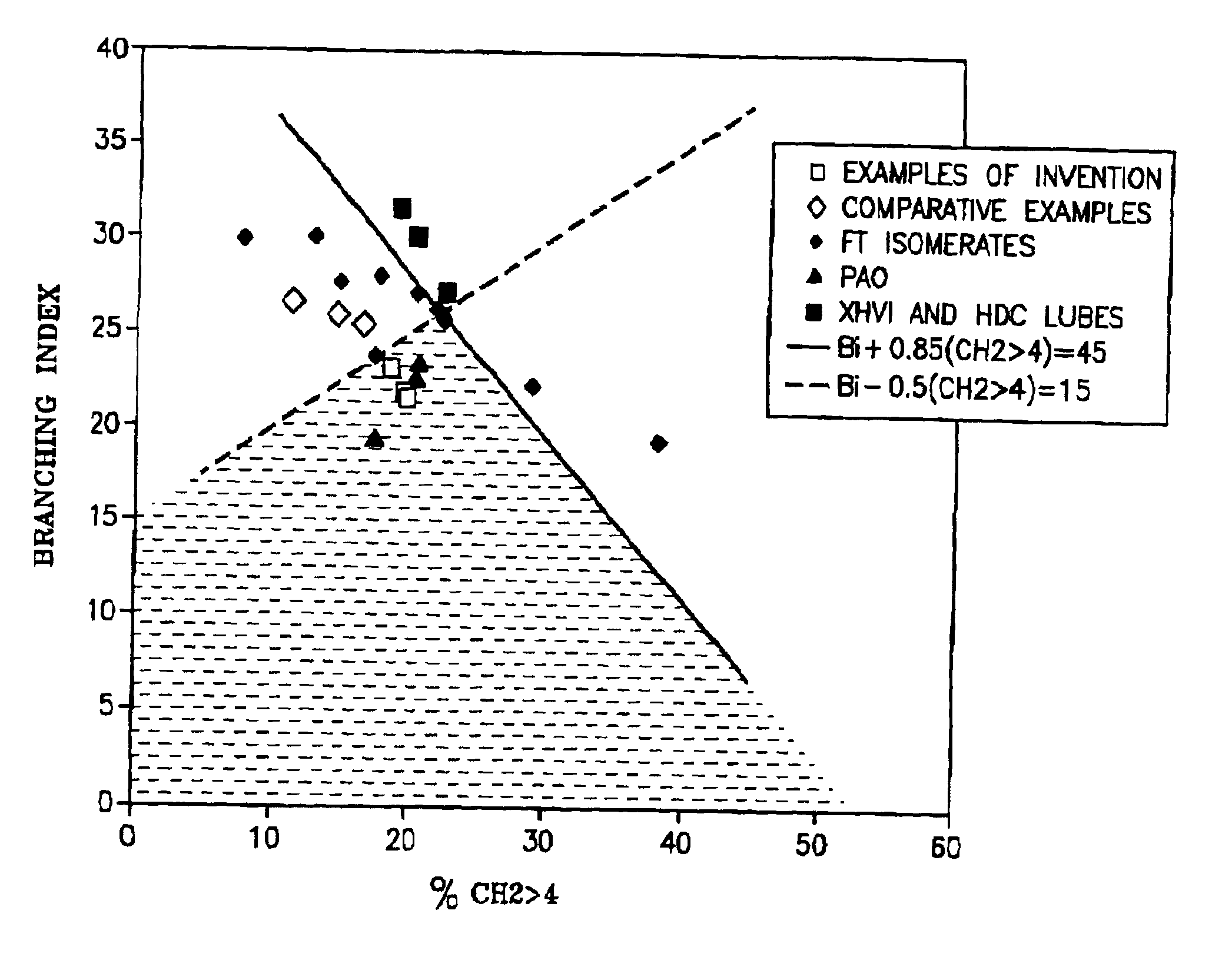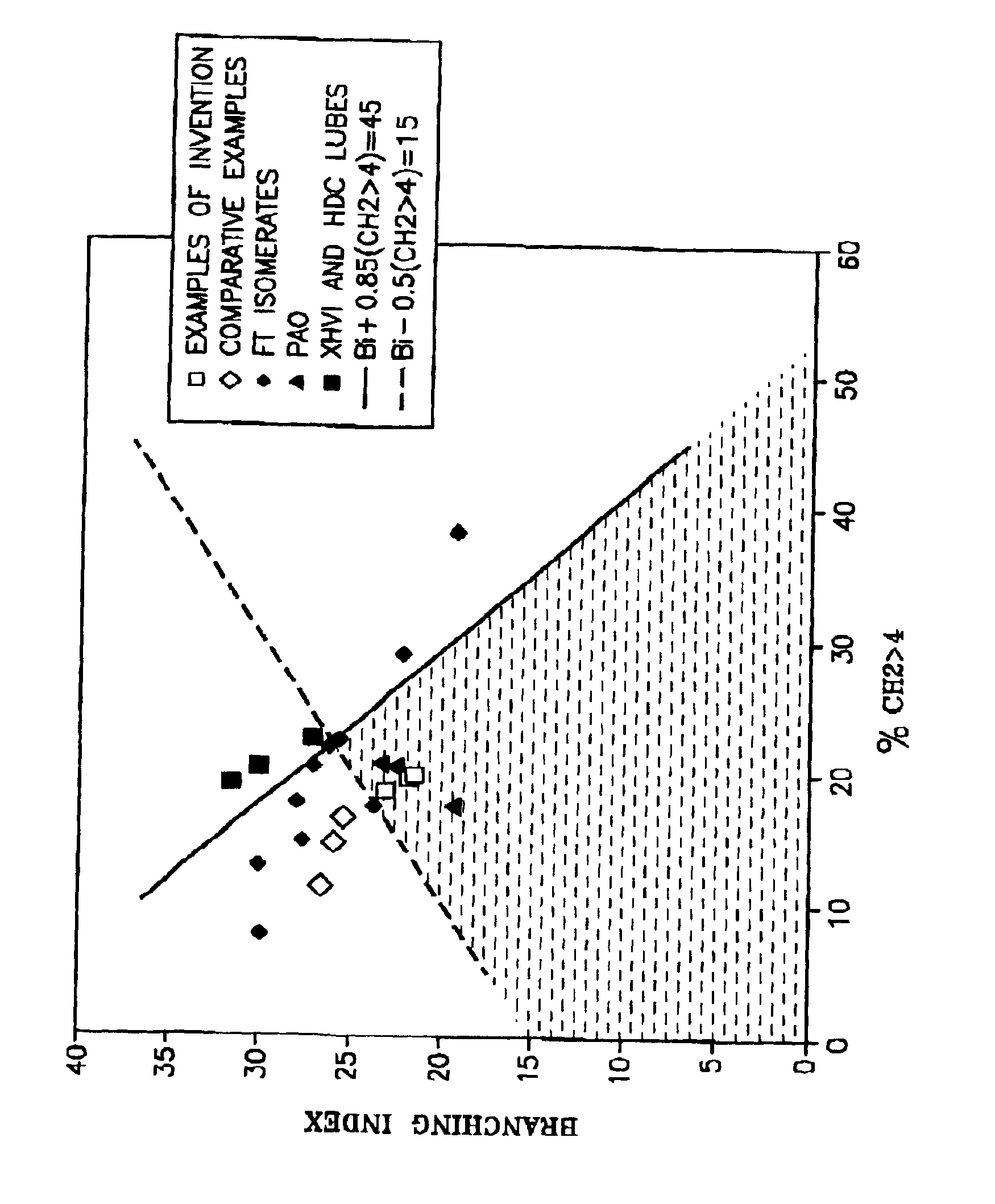Synthetic isoparaffinic premium heavy lubricant base stock
a technology of heavy lubricant and synthetic isoparaffin, which is applied in the direction of lubricant composition, liquid carbonaceous fuel, fuel, etc., can solve the problems of low yield of product oil, reduced viscosity and stability of oil, and lubricant based on a lighter oil cannot provide sufficient lubrication between moving parts
- Summary
- Abstract
- Description
- Claims
- Application Information
AI Technical Summary
Benefits of technology
Problems solved by technology
Method used
Image
Examples
example 1
In this example, the wax feed comprised the entire 430° F.+ (221° C.) waxy hydrocarbon fraction produced in a slurry Fischer-Tropsch hydrocarbon synthesis reactor, that contained a titania supported, rhenium-promoted, non-shifting cobalt hydrocarbon synthesis catalyst. The wax comprised at least 90 wt % normal paraffinic hydrocarbons and 26.2 wt % of a 1000° F.+ (538° C.) fraction. It was hydrodewaxed with hydrogen in the presence of a ZSM-48 hydrodewaxing catalyst to form an isomerate. The isomerate was fractionated to remove the 700° F.− (371° C.−) hydrocarbons and the remaining 700° F.+ (3716° C.+) fraction then fractionated to remove and recover a 950° F.+ (510° C.+) heavy lubricant isomerate fraction. This heavy isomerate fraction was then further hydrodewaxed with hydrogen, over the same ZSM-48 hydrodewaxing catalyst in a separate reactor, to form heavy hydrocarbon or lubricant base stock compositions of the invention. The hydrodewaxing conditions in the first and second react...
example 2
In this example, the wax feed was Paraflint C-80, a commercally available, hydrotreated Fischer-Tropsch wax produced by Sasol in a fixed bed Fischer-Tropsch reactor from a shifting iron catalyst. The untreated raw wax contains relatively high levels of aromatic and aliphatic unsaturates, and heteroatom compounds, which is hydrotreated to produce the Paraflint C-80 wax. This solid wax is a distillate fraction having a viscosity ranging from 6-10 cSt at 100° C. and a nominal T5 boiling point of about 850° F. (454° C.). It was hydrodewaxed with hydrogen in a single reactor, in the presence of a Pt / ZSM-48 catalyst similar to that used above, but which had been sulfided. The hydrodewaxing reaction pressure was 1000 psi (6895 kPa). The hydrodewaxing product was fractionated by distillation to give a hydrocarbon or heavy lubricant base stock composition of the invention with a viscosity of 11 cSt at 100° C. and its properties are also shown in the Table.
PUM
| Property | Measurement | Unit |
|---|---|---|
| end boiling points | aaaaa | aaaaa |
| end boiling points | aaaaa | aaaaa |
| kinematic viscosity | aaaaa | aaaaa |
Abstract
Description
Claims
Application Information
 Login to View More
Login to View More - R&D
- Intellectual Property
- Life Sciences
- Materials
- Tech Scout
- Unparalleled Data Quality
- Higher Quality Content
- 60% Fewer Hallucinations
Browse by: Latest US Patents, China's latest patents, Technical Efficacy Thesaurus, Application Domain, Technology Topic, Popular Technical Reports.
© 2025 PatSnap. All rights reserved.Legal|Privacy policy|Modern Slavery Act Transparency Statement|Sitemap|About US| Contact US: help@patsnap.com


